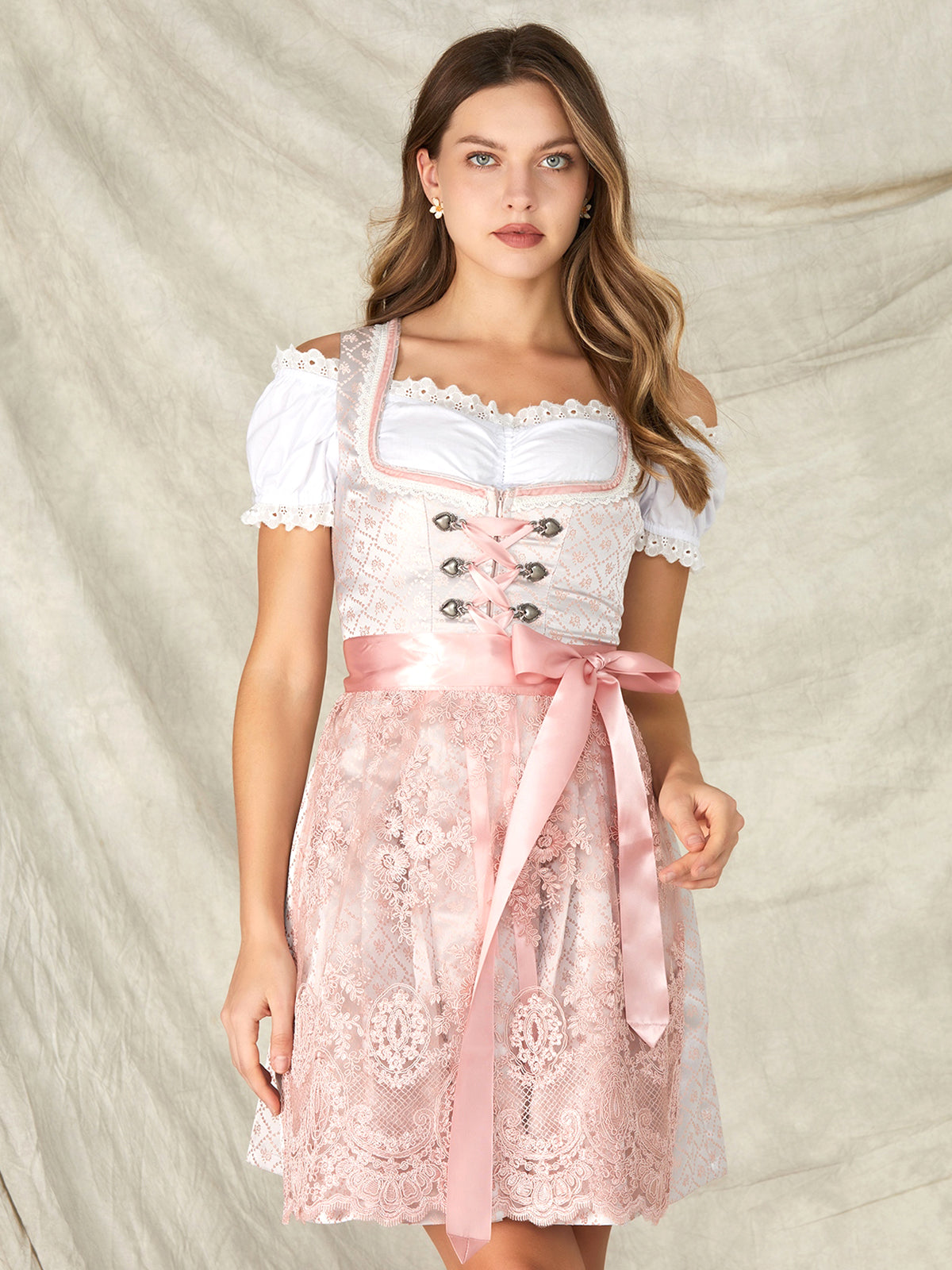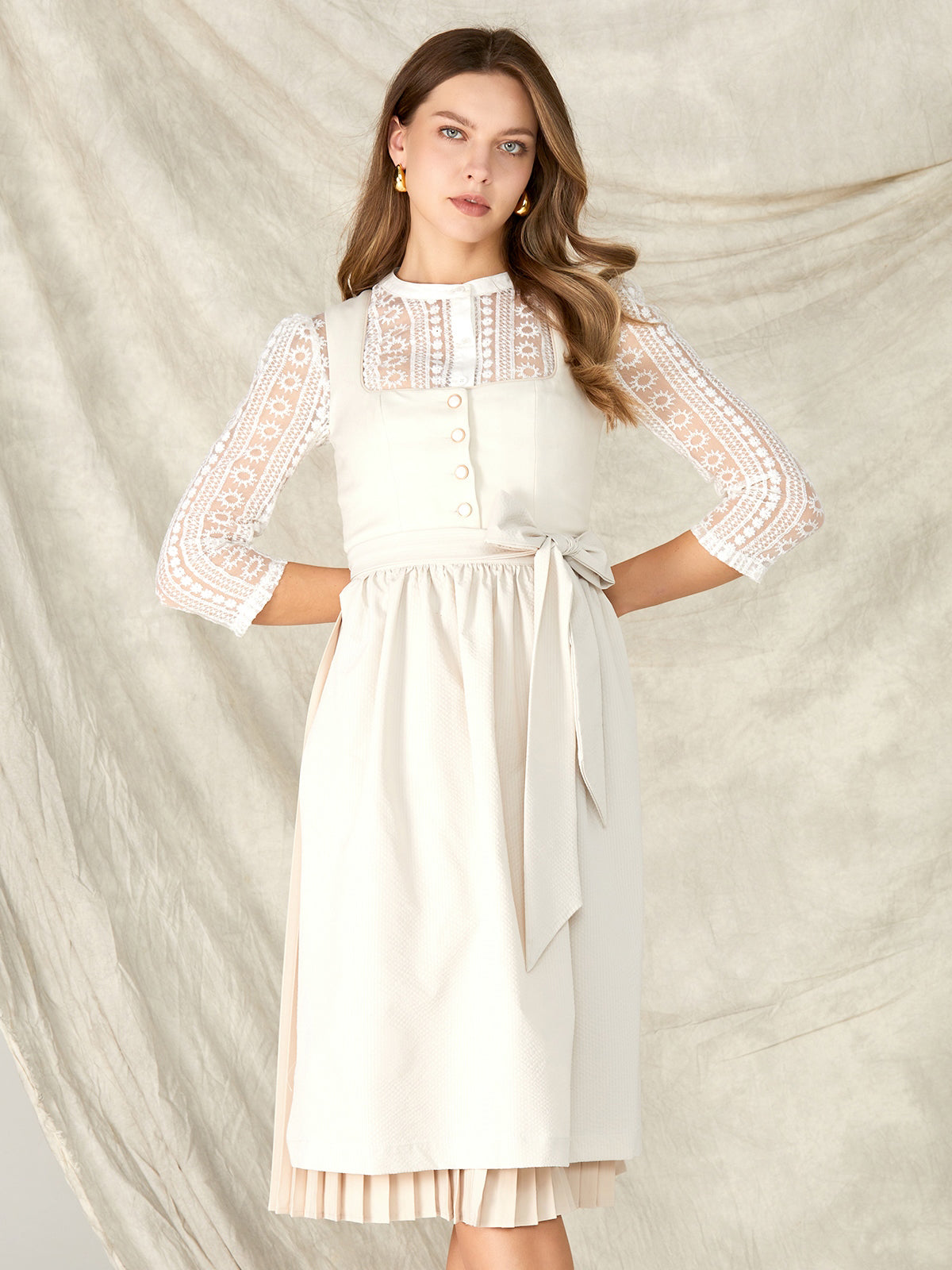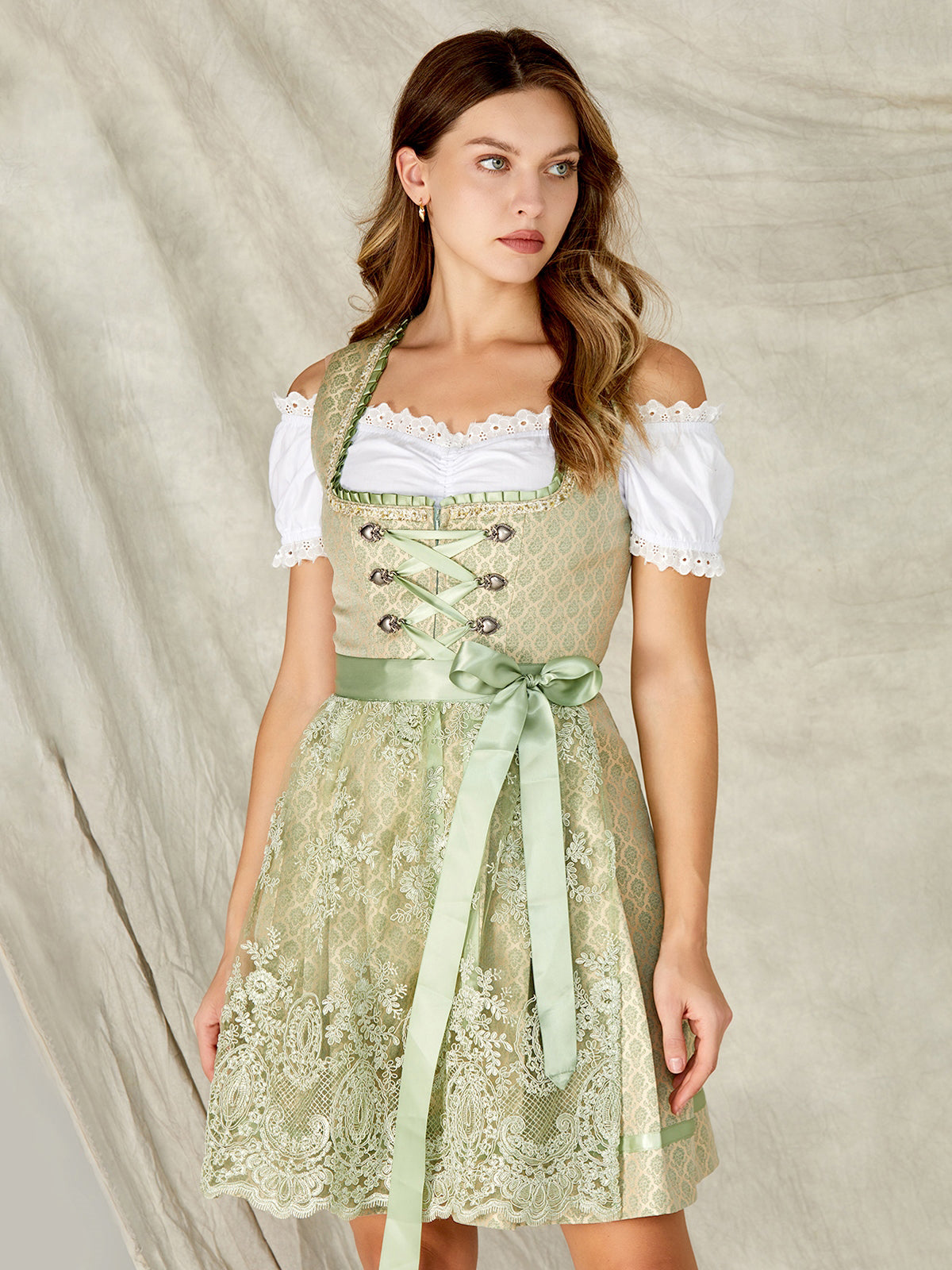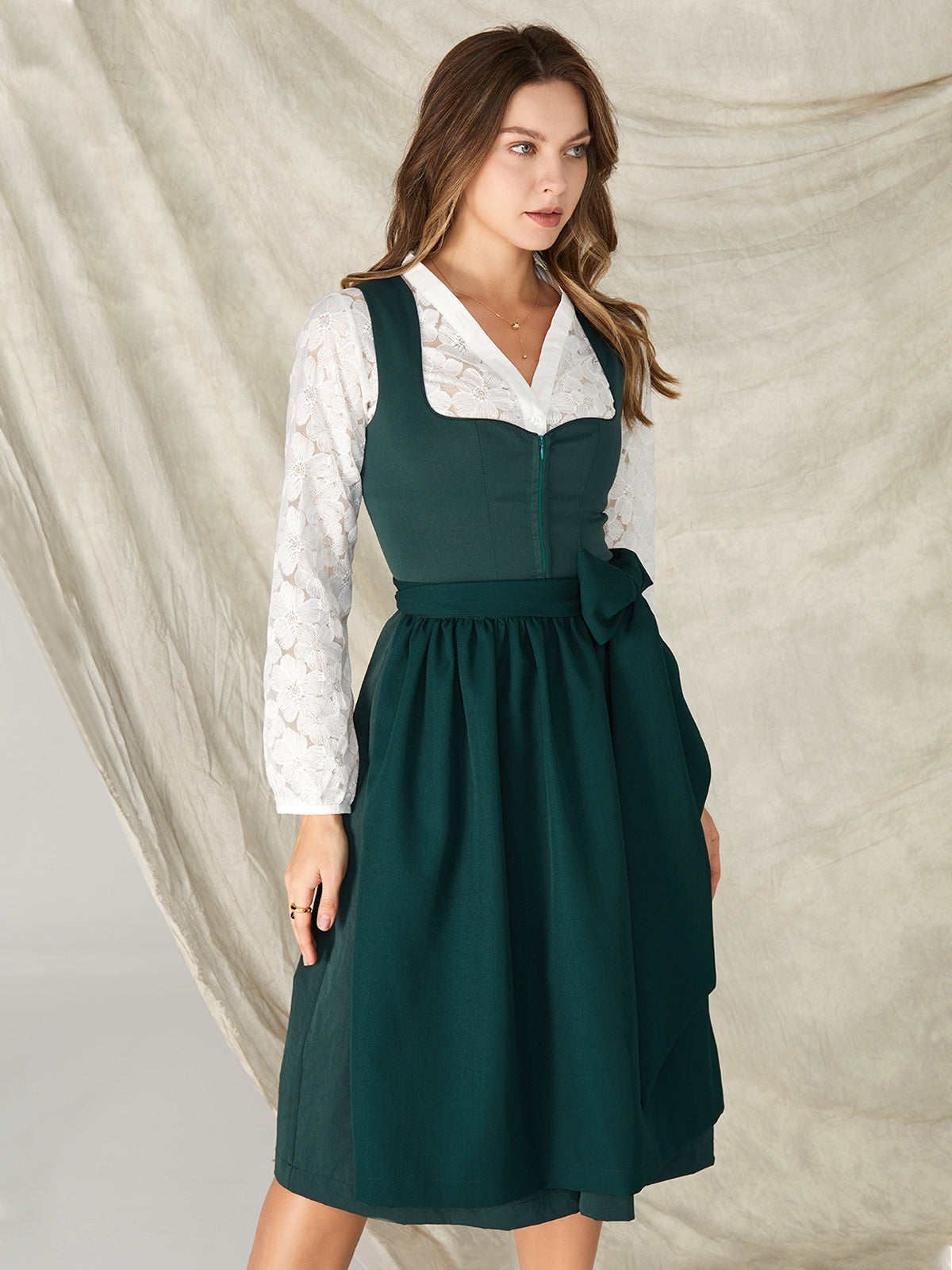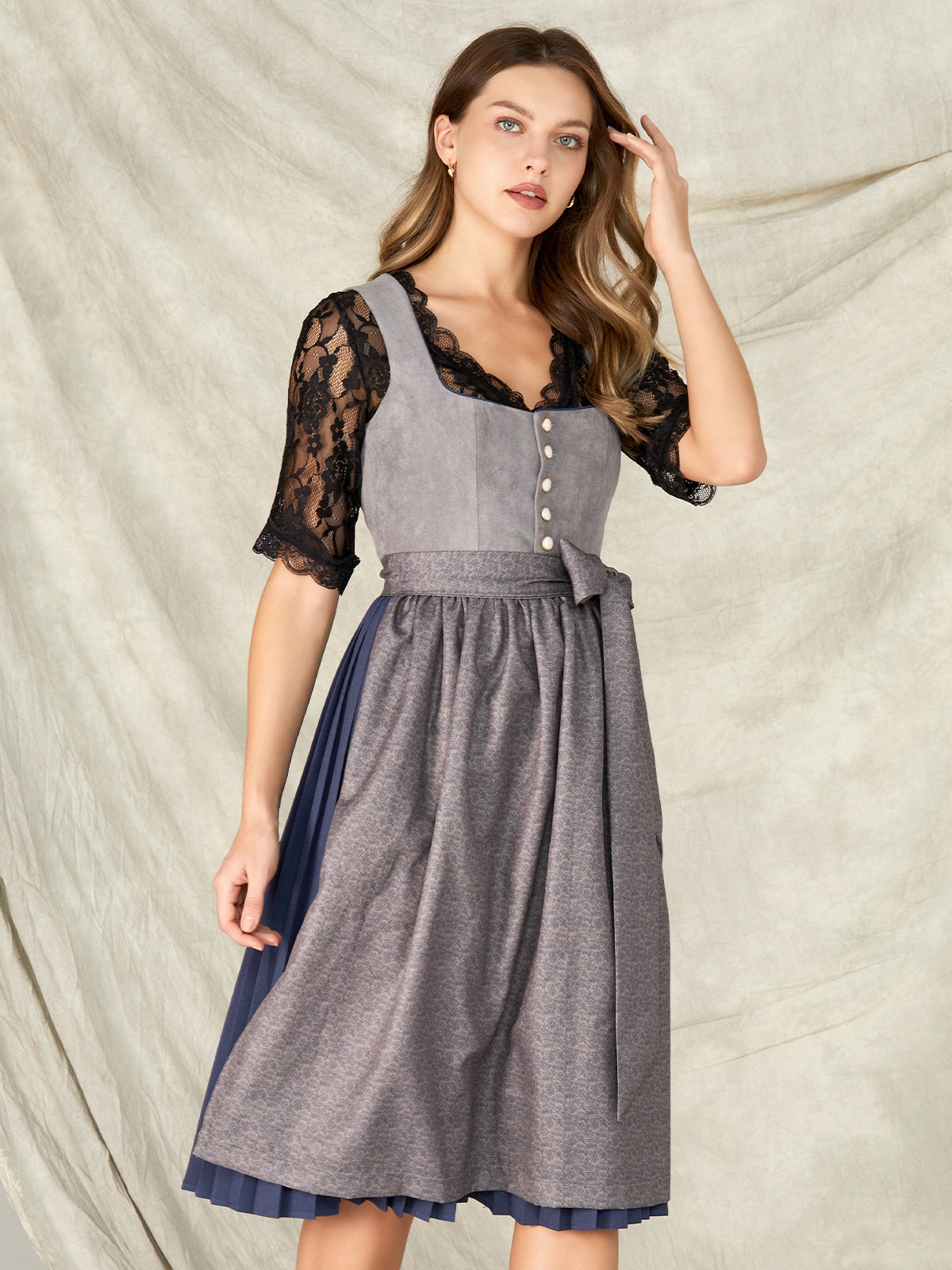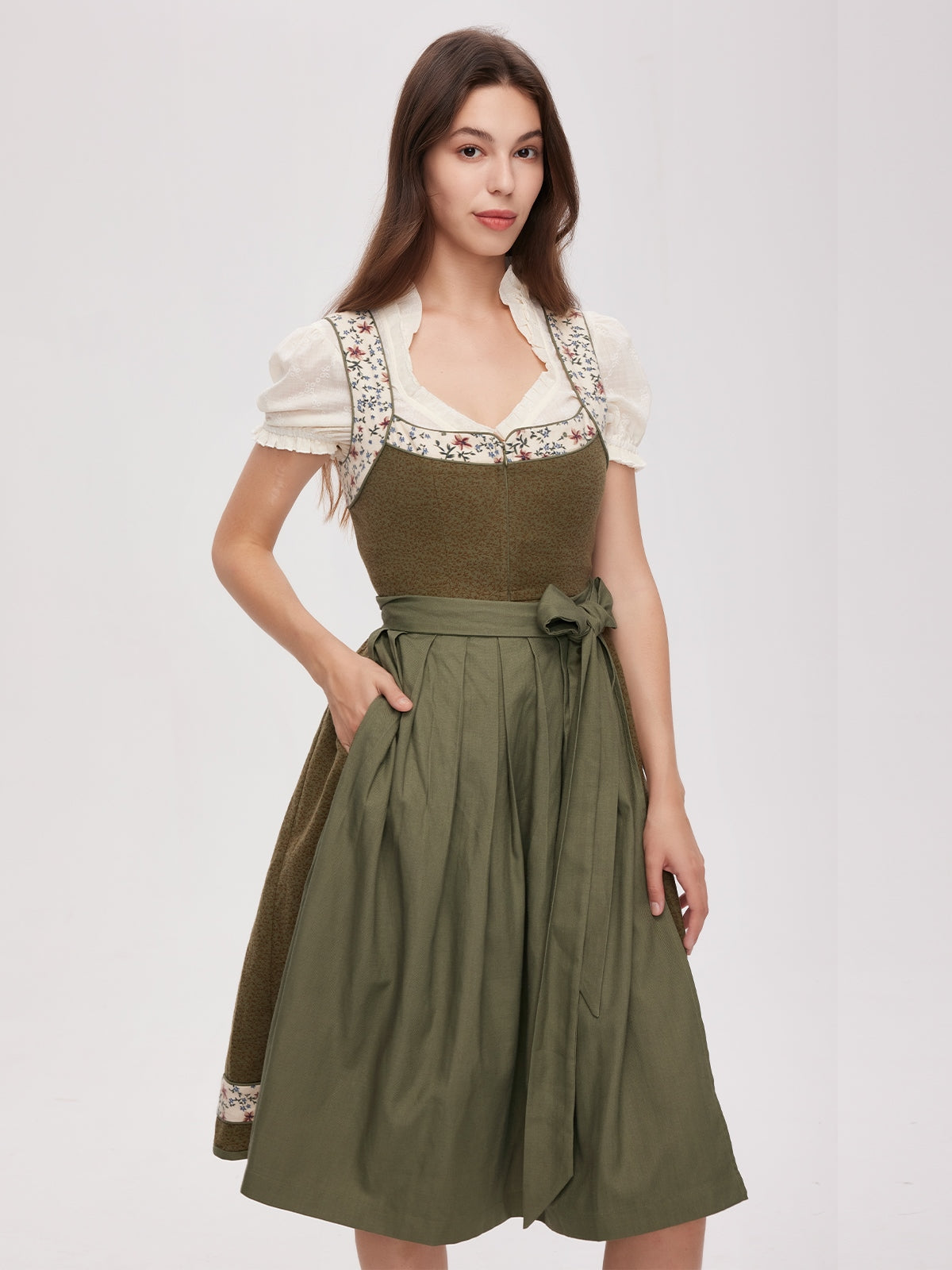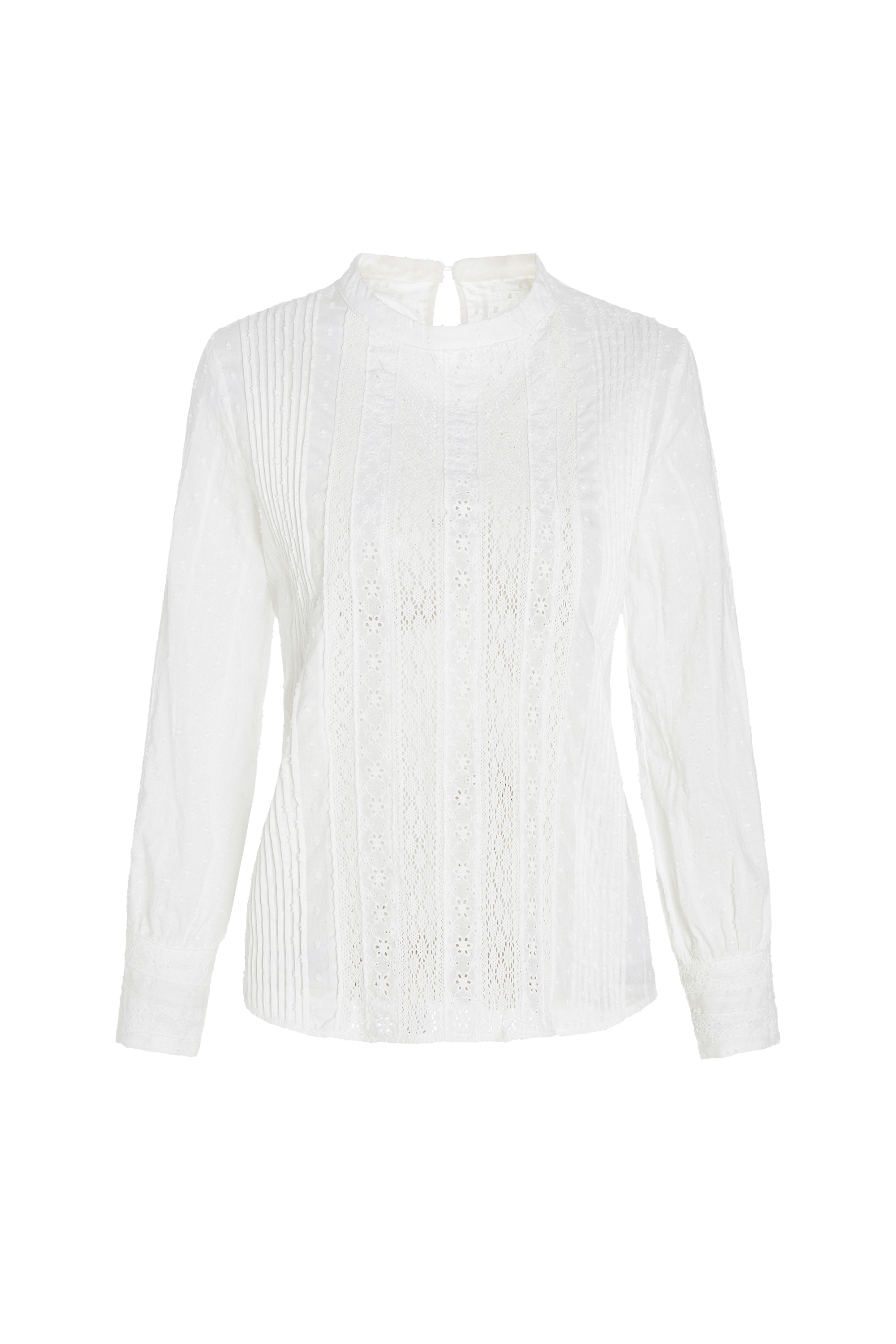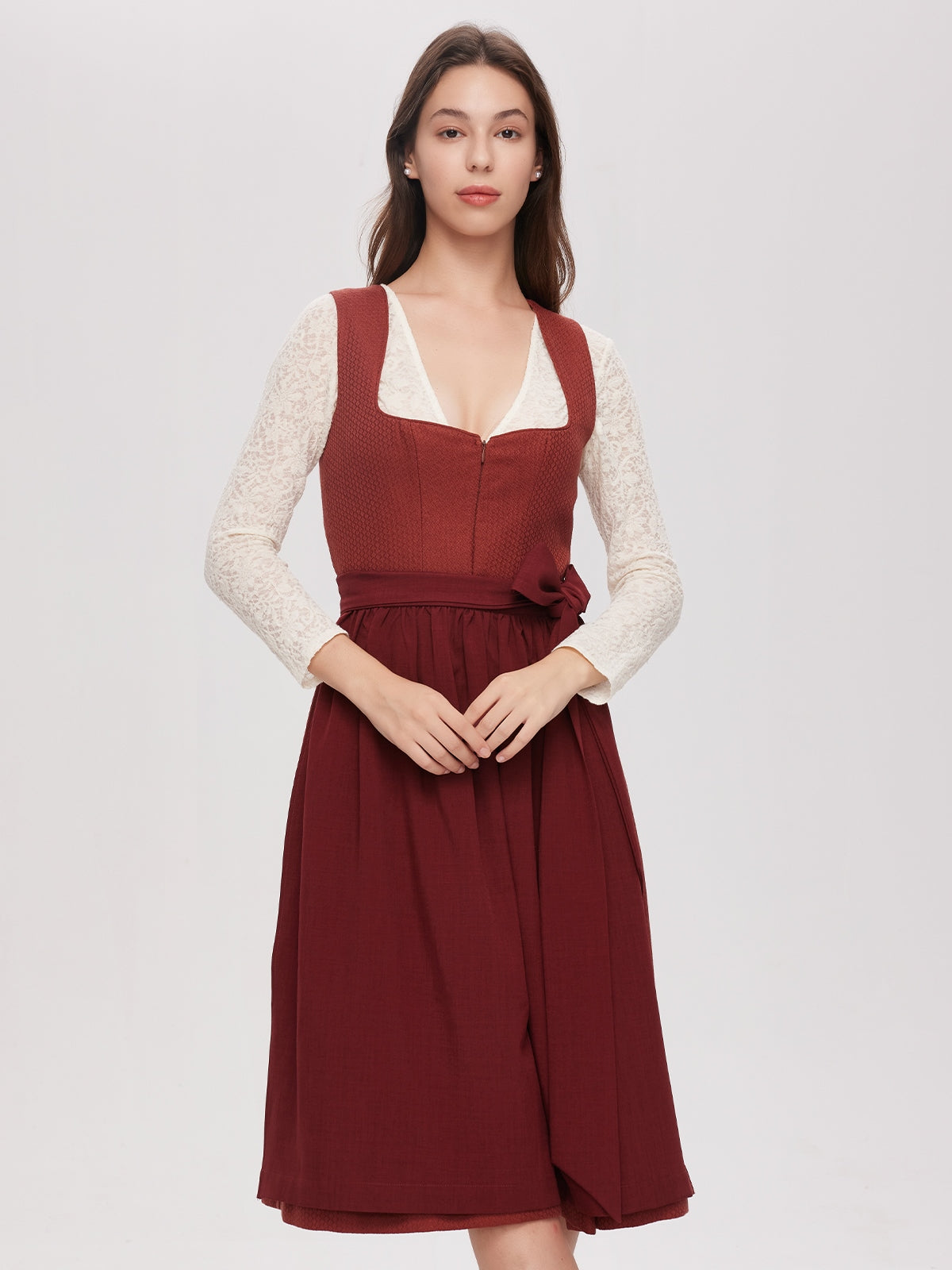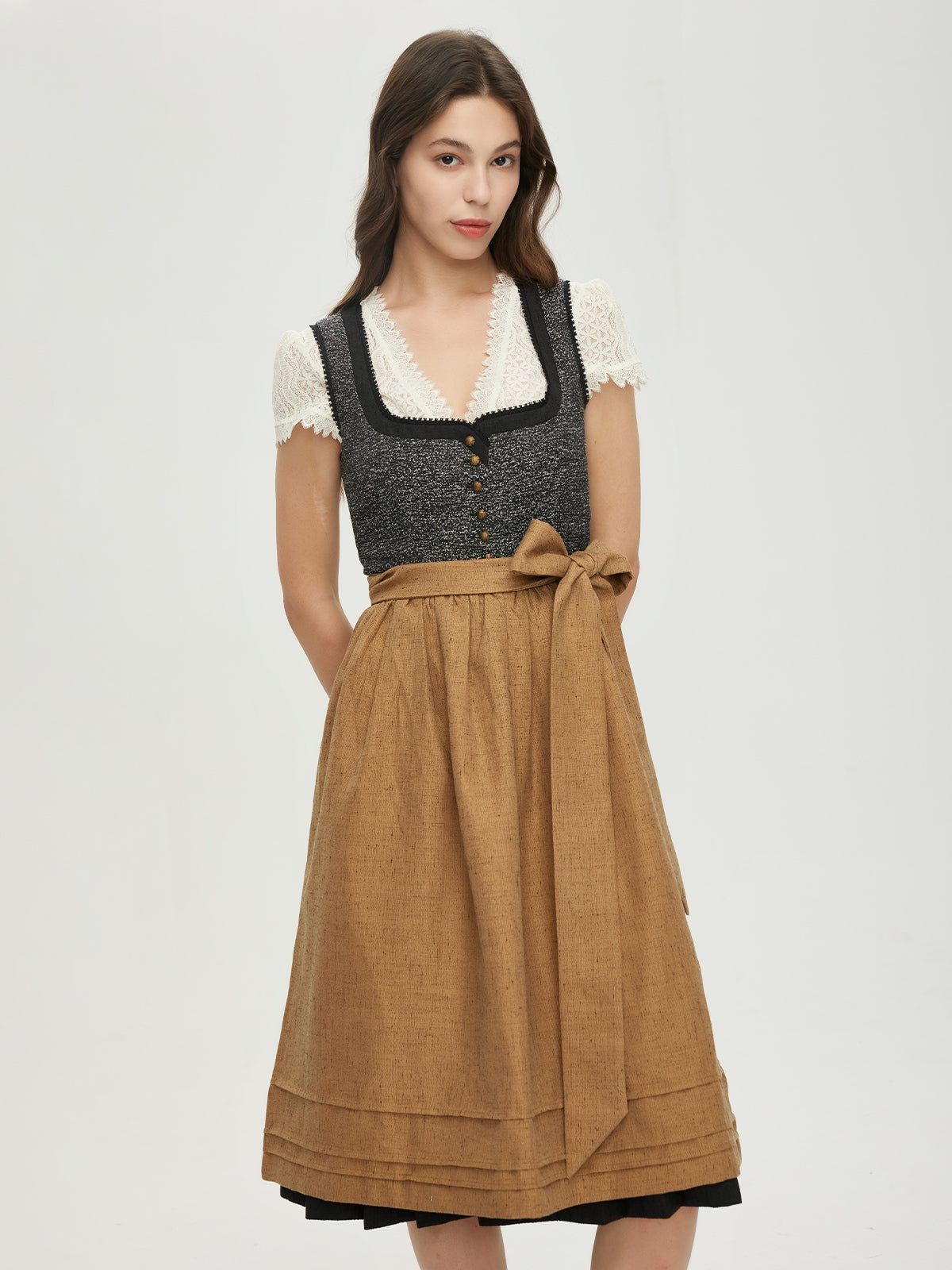The importance of green in culture
Green is a color with special significance worldwide. It represents nature, growth, freshness, and harmony. In Bavarian and Austrian traditional costumes, green is often used to emphasize the connection with nature and the natural beauty of the landscape. The color variants dark green, pastel green, and sage green therefore offer not only aesthetic advantages but also cultural depth.
Dark green – the color of earthiness
Dark green is a color that exudes stability and strength. It is the color of the forest, the earth, and tranquility. A " dark green velvet dirndl " conveys a sense of earthiness and strength. It is ideal for people rooted in nature and want to express their connection to the environment. Dark green is also a color that complements every skin tone and makes the wearer appear elegant and confident.
Pastel green – the color of freshness and tenderness
Pastel green is a delicate and soft color that exudes freshness and lightness. It's the perfect choice for those who want to create a subtle yet striking look. A pastel green dirndl is ideal for spring and summer, when nature displays its freshest colors. Pastel green also combines well with other pastel shades to create a harmonious and balanced look.
Sage Green – The Color of (Gu Ya, Ancient Elegance)
Sage green, also known as ochre green, is a color reminiscent of bygone times and exudes a certain antique elegance. It's the color of old cloths, old houses, and old stories. A "sage green velvet dirndl" is therefore ideal for those who want to establish a connection to old traditions while simultaneously emphasizing their individuality. Sage green is a color that tells a story while exuding modern elegance.
The quality of the velvet fleece
Whether in dark green, pastel green or sage green, the velvet fleece from which many of these dirndls are made plays an important role in the appearance and durability of the dress.
Velvet fleece – elegance and comfort
Velvet fleece has a luxurious texture and feels soft and comfortable against the skin. It has the ability to reflect light in a special way, making colors appear even deeper and more intense. A dirndl in velvet fleece, whether dark green, pastel green, or sage green, becomes even more striking and beautiful. The fineness of the velvet fleece makes the dirndl a true eye-catcher and lends the wearer a sense of grace and appeal.
Care and durability
Of course, a velvet dirndl requires a little more effort when caring for it. It should be dusted regularly to prevent the fibers from sticking together. When cleaning, it's advisable to rely on professional cleaning at a dry cleaner to preserve the quality of the fabric and ensure you can enjoy your dirndl for a long time. Careful care is necessary to ensure the beauty and longevity of the velvet dirndl.
Design and cut of the dirndl
In addition to the color and fabric, the design and cut of a dirndl are also crucial for its appearance.
Classic dirndl cut
The classic dirndl cut features a tight bodice that flares out into a wide, bell-shaped skirt. This cut perfectly accentuates the feminine curves and conveys a sense of grace and allure. Whether a dirndl is in dark green velvet, pastel green, or sage green velvet, the combination of the matching cut and color makes it a true eye-catcher. The classic cut is timeless and is continually being interpreted in a modern way.
Modern variations
Today, however, there are also many modern variations of the dirndl. You can find dirndls with asymmetrical cuts, special appliqués, or unusual lengths. A "dark green velvet dirndl" or "sage green velvet dirndl" can thus be made even more individual and unique, reflecting the wearer's taste and personality. Modern variations offer new ways to place the traditional dirndl in a contemporary context.
Materials and workmanship
The choice of the right material and the quality of workmanship are decisive factors for the appearance and durability of a dirndl.
High-quality fabrics
Besides velvet, other materials can be used for dirndls, such as silk, cotton, or synthetic fibers. However, velvet still holds a special place in the world of dirndls, offering a luxurious look and a comfortable feel. When making a dirndl in velvet, whether dark green, pastel green, or sage green, great care is taken to ensure that the seams are tight and precise and that the fabric is evenly processed. The quality of the materials is crucial to ensuring the dirndl's beauty and durability.
Processing techniques
There are various finishing techniques that can be used in the creation of a dirndl. These include patches, embroidery, or trim. A dirndl in "Sam tvlies" (satin fabric, be it dark green, pastel green, or sage green) can be made even more beautiful and eye-catching with fine embroidery or elegant trim. The finishing techniques play an important role in highlighting the individual characteristics of the dirndl and making the wearer unique.
Different occasions for dirndls in dark green, pastel green and sage green
The choice of a dirndl in dark green, pastel green or sage green depends largely on the occasion for which it is to be worn.
Festive occasions
For large celebrations and festivities such as folk festivals, church fairs, or weddings, a dirndl in dark green velvet is a perfect choice. The deep and intense color nuances and the luxuriousness of the velvet fleece draw attention and make the wearer appear proud and confident. A dirndl in "velvet fleece, be it dark green," will always be well received at such occasions and make the wearer part of the festive atmosphere.
Suitability for everyday use
Even if you prefer to wear a dirndl more everyday, there are ways to achieve this. A dirndl in pastel green or sage green, for example, can be a perfect outfit for a romantic stroll or a special dinner. The more subdued colors also pair well with casual accessories while still making the wearer appear elegant and stylish. The everyday suitability of pastel and sage green dirndls makes them a versatile choice for any occasion.
The cultural significance of the dirndl
The dirndl is not only a piece of clothing, but also a symbol of cultural tradition and identity.
Regional pride
In Bavaria and Austria, the dirndl is a symbol of regional identity and pride. People wear it with joy to show their connection to their homeland and culture. A "dark green velvet dirndl," a "pastel green dirndl," or a "sage green velvet dirndl" is part of this tradition and is worn on various occasions to celebrate cultural identity. The color variations offer different ways to express regional pride while simultaneously emphasizing individual charisma.
International fame
Recently, the dirndl has also gained international recognition. Tourists from all over the world come to Bavaria and Austria to experience traditional costumes and wear a dirndl themselves. A dirndl in dark green, pastel green, or sage green thus has an international appeal and is loved by many people around the world. The dirndl's international popularity demonstrates its universal appeal and its appeal to people from different cultures.

